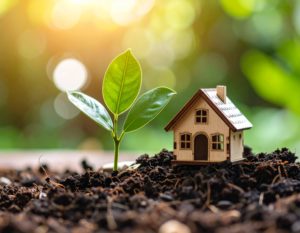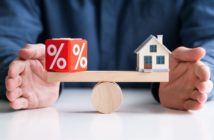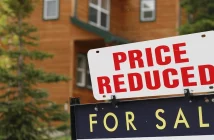While the market remains largely flat overall, with the average home value increasing by just 0.9% in the September quarter to $899,256, the latest QV House Price Index shows small green shoots of recovery spreading throughout much of the country

Twice as many of the main urban centres we monitor experienced positive home value growth in the September quarter than in the August one, with Invercargill (3.2%), Auckland (1.6%), Wellington (1.5%), and Queenstown (0.9%) heading a list of ten.
All bar one of the main centres showed either positive home value growth or the rate of decrease softening this quarter. The exception was New Plymouth, where its rate of reduction increased to 1.5% in September. That was the second largest average home value reduction, after the 1.8% decreases recorded this quarter in both Whangārei and Nelson.
Quotable Value (QV) operations manager James Wilson says the market is flat right now, but we certainly are starting to see signs of life once more.
“A recovery is underway, which is largely being fuelled by first-home buyers. They remain the most active group by far, but we’re also now starting to see it expand beyond just entry-level locations for the first time.
“The mindset seems to be shifting within our main urban centres, with even Wellington gaining a small amount of momentum after experiencing some of the largest declines since the downturn began in late 2021. Though people remain cautious, prospective buyers have been watching the market bottom out, and even start to increase a little bit in some areas, and now they’re getting increasingly active. A return to record migration is also helping to fuel demand.”
He says this increase in competition was putting upward pressure on prices, with the number of new property listings coming onto the market also remaining largely flat overall. “We’ve been experiencing a bit of a spring clean-out of old housing stock that has been sitting on the market for a while, but we’re still yet to see the spring surge in listings that we’d typically see this time of year.”
“If the weather allows it, we’ll likely see an uptick in residential property listings after the election. Until then, there is still lots of uncertainty out there, and markets don’t tend to respond too well to uncertainty, especially while such strong economic headwinds continue to blow. For that reason alone, I expect the market will stay flat to gently rising for the foreseeable future,” Mr Wilson added.

Northland
Residential property values continue to zig and zag in Northland.
Home values slipped back another 1% on average across the wider region in the September quarter. However, Kaipara District (-5.8%) fared considerably worse than average, and the Far North District (+2.5%) fared considerably better.
In Whangārei, the average home value has decreased this quarter by 1.8% to $723,826. That figure is 8.8% lower than the same time last year.
Local QV registered valuer Renee Pilkington commented: “Open-home attendance has been quiet over the last couple of weeks. New listings coming on the market are low, which is unusual for spring and is resulting in less selection amongst buyers.”
“There has been a slight pick up in coastal sales, which have been relatively quiet over winter,” she added.
Auckland
Auckland has experienced another modest month of positive home value growth.
The region’s average home value increased by 0.8% in September to $1,261,919, with six out of seven of the Super City’s seven former territorial authorities also experiencing small increases last month.
However, home values remain 7.1% lower on average than the same time last year, and 5.8% lower than at the start of 2023.
Local QV valuer Hugh Robson commented: “The Auckland residential market continues to show signs of modest recovery. However, we’re still waiting for the spring surge in listings. Listings on the market remain quite low, which may result in some upward price movement in coming months.”
He said there had been an uptick in interest at open homes and auctions throughout the city. “First-home buyers make up a large portion of people looking at property. Many of them have been looking at new townhouses and apartment developments.”
“It appears many investors are continuing to hold off for now, potentially waiting to see what happens with the upcoming election,” Mr Robson added.
Tauranga
The residential property market appears to have largely flattened out in Tauranga.
The city’s average home value increased by 0.4% to $1,002,206 this quarter. But the average value is still 7.1% less than at the same time last year, and 6.9% less than at the start of the current calendar year.
QV property consultant Derek Turnwald said there remained a “low volume of sales” and “much uncertainty” in the market and economy in general – especially with the election looming.
“Local agents are reporting increased interest from investors, with the chance that a new government will come to power later this year and reinstate more favourable tax implications for investment and holiday home owners. But investors are tire kicking and remain non-committal in the meantime.”
“First-home buyers are still the most active group in the market, despite high interest rates and tight lending conditions,” he added.
Waikato
Home values in Hamilton have remained largely static this quarter.
The city’s average home value increased by just 0.1% to $776,133 throughout the three months to the end of September 2023, with central Hamilton (2.4%) experiencing the most growth in that time and the city’s north east suburbs experiencing the least (-0.7%).
QV property consultant Marshall Wu commented: “As we move into the spring season, there is a noticeable trend of recovery in the context of relatively low levels of purchasing activity. However, the outlook for housing values remains uncertain due to several factors – including expectations of higher interest rates, a softer economic environment, and increased household spending.
“In addition to that, shifts in global economic conditions or domestic political changes have the potential to influence interest rate decisions in unpredictable ways.”
Across the wider region, the average home value slipped back 1.3% to $790,991. “Regional markets continue to slow down due to the same factors and market conditions that Hamilton and the rest of New Zealand have encountered over the past 12 months,” Mr Wu added.
Rotorua
Residential property values have experienced another small decline this quarter in Rotorua.
The latest QV figures show that home values have reduced locally by an average of 0.3% throughout the last three months to the end of September, which is a slight improvement on the 1.4% average decline recorded throughout the three months to the end of August.
The average home value in Rotorua is now $642,478, which is 7.5% lower than it was 12 months ago and 4.3% lower than at the start of 2023.
QV property consultant Derek Turnwald commented: “Tourist numbers appear to be growing now, which is very good news for Rotorua. Foreign student numbers are also increasing, which is really positive for the local economy.
“As for the local property market, it’s still experiencing subdued demand, but attendance at open homes is improving now that we’re in spring.”
Taranaki
Taranaki’s residential property market has yet to hit rock bottom.
The latest QV House Price Index shows home values reduced across the region by an average of 1.2% this quarter. Stratford led the downward charge with an average reduction of 2.9%, followed by New Plymouth with an average reduction of 1.5%.
At the other end of the spectrum, South Taranaki District experienced a 1% average increase in home value in the September quarter.
Hawke’s Bay
Green shoots of growth have appeared across all of Hawke’s Bay’s districts this quarter.
The average home value has increased across the region by 0.9% throughout the three months to the end of September. In Napier, the average home value increased by 0.2% to $738,559, and Hastings saw significantly more growth, with the average home value increasing by 1.4% to $775,929.
QV Hawke’s Bay manager Damian Hall commented: “In the past two months we’ve seen a good clear out of old stock, but not a lot coming to the market. People appear to be holding tight until after the election. Then we’ll likely see more activity heading into late spring and the summer months.”
He said first-home buyers remained the most active group in the market, especially in Hastings, where the lower quartile average had increased by 3.3% in the last month alone.
“The top end is also holding well with some strong sales for good quality properties. Properties that are run down and require a lot of work are struggling to sell, as people simply can’t afford major renovations or are not prepared to wait extended periods to get the work done.”
“New builds are becoming less popular as timelines and consent processes are being pushed out, and build costs are so high and variable,” he added.
Palmerston North
Home values in Palmerston North have remained largely flat this quarter.
The latest QV House Price Index shows the city’s average home value has remained largely static since the end of June at $627,354. However, residential property values are still on average 6.4% lower than the same time last year.
Local QV registered valuer Olivia Betts said sale prices appeared to have levelled off over the last three months. “Traditionally the lead up to elections is slow, but we have seen a small increase in market activity. Active agents in the market believe this is due to purchasers wanting to get in before investors if there is a change of government.”
Wellington
September marked the Wellington region’s first quarterly home value increase since the residential property downturn began in late 2021.
The latest QV House Price Index shows the region’s average home value increased by 1.5% to $837,935 throughout the three months to the end of September, following two consecutive months of positive growth.
Hutt City (-0.1%) was the only local territorial authority that experienced a small decline, with Porirua (3.4%) recording the largest average increase.
“The general sentiment is the market has now turned a corner,” said local QV senior consultant David Cornford.
“The slight value increase seen over the last few months is likely a result of the continued constrained housing supply in the region and an increase in the number of buyers who have been delaying purchasing over the last few years while they wait for the market to bottom out.”
“However, there are economic headwinds ahead and potential for further interest rate rises and this will likely dampen any significant value growth in the short to medium term,” Mr Cornford added.
Nelson
Home values have reduced by an average of 1.8% this quarter in Nelson.
The city’s average home value is now $765,298, which is 4.4% lower than the same time last year.
QV Nelson/Marlborough manager Craig Russell commented: “We’re still seeing a number of price reductions. Some properties have been on the market for an extended period with a clear variance between the vendors’ price expectations and what purchasers are actually prepared to pay.
“Entry-level housing in Toi Toi and Tāhunanui is struggling to sell with first home buyers restricted by tighter lending rules, and investors seeking better returns.”
“Mortgage interest rates continue to creep up, which combined with a rise in new listings will likely limit any potential house price growth in the short term,” he added.
West Coast
Home values have increased by an average of 3.1% on the West Coast this quarter.
It’s an improvement on the 2.6% average quarterly increase reported in the previous QV House Price Index, with the region’s average annual growth rate now sitting at 4%.
Broken down by district, home values are down on average again this quarter in Buller (-3.2%) but up on average in Grey District (8%) and Westland (2.6%).
Canterbury
Christchurch’s residential property market has entered spring with a small amount of upward momentum.
The Garden City’s average home value increased by 0.6% throughout the September quarter to reach $734,681, with its three-month rolling rate of growth remaining positive for the third straight month.
“The spring upswing has set in with another monthly increase in home values in Christchurch, as well as the wider Canterbury region,” said local QV registered valuer Olivia Brownie.
“There has been an increase in buyer interest over the past few months – including by some investors – which coupled with the limited amount of stock available to purchase and high interest rates is providing the foundation for some steadiness in the market. An increase in net migration is also having an implication on rents, availability of tenants, and house prices.”
“It’s only a slight recovery at this point, due to strong economic constraints,” Miss Brownie added.
Dunedin
Dunedin’s declining rate of residential property value has eased.
The latest QV House Price Index shows the city’s average home value reduced by 0.6% in the September quarter to $610,140. That is an improvement on the 1.7% average decline in the August quarter. Values are now 5.6% lower than at the same time last year.
Local QV registered valuer Rebecca Johnston commented: “The number of properties for sale in Dunedin remains relatively level. This highlights a tightening of supply versus demand, compared to the past 12 months. So real estate agents are now reporting limited listings and fewer choices for purchasers, despite increasing numbers of prospective buyers attending open home viewings.”
“However, properties requiring maintenance, repairs and upgrades are still being viewed less favourably by both buyers and lenders. They often require extended selling periods as a result,” she added.
Queenstown
Queenstown’s residential property market has largely stabilised.
Its average home value increased by 0.9% to $1,726,315 in the September quarter, which is a fraction of a percentage point higher than last month’s quarterly rate of home value growth.
The average home value is now 1.9% higher than the same time last year, compared to a 6% average annual home value loss nationally.
Invercargill
Invercargill is the leader of the pack this quarter.
The city’s rolling three-monthly rate of home value growth has continued to build for the fourth month in a row, increasing from 0.2% in June to 0.8% in July, 1.5% in August, and now 3.2% in September. The average home value locally is now $468,009.
Local registered valuer Andrew Ronald commented: “Prices have stopped falling now and have begun to strengthen. However, while there is still healthy demand from first-home buyers, there are limited investors as a result of continued interest rate increases and tax deductibility rules.”
Invercargill’s average home value is now 1.5% lower than the same time last year, and 0.3% higher than at the start of 2023.









